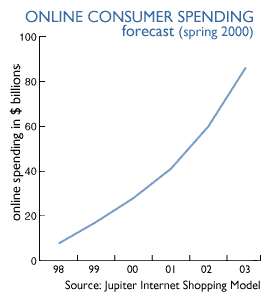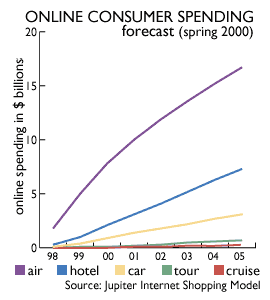|
The battle for holiday 2000
|
 |
May 26, 2000: 4:37 p.m. ET
Dot.com retailers focus on order fulfillment in a fight to survive
By Staff Writer John Chartier
|
NEW YORK (CNNfn) - Instead of presents, many found pictures in those prettily wrapped boxes last December - pictures of holiday gifts ordered over the Internet.
"It didn't get here yet" became as common a refrain as a Bing Crosby hit.
After luring seven million new households to the Internet last Christmas, many e-tailers became overwhelmed - unable to fulfill the crush of orders in the last few weeks before Christmas.
And with at least 11 million new households expected to do their holiday shopping online this year, "fulfillment" has become the retailers' rallying cry as they fight to survive holiday 2000.
 "Fulfillment is an issue. They basically have one chance during the year to get fulfillment right, and if they don't, they stand to lose customers," said Liz Leonard, an analyst with Gomez Advisors. "Fulfillment is an issue. They basically have one chance during the year to get fulfillment right, and if they don't, they stand to lose customers," said Liz Leonard, an analyst with Gomez Advisors.
Making sure orders are delivered on time, that customers are kept up to date on the status of their orders, proper billing and a dozen other "back-end" operations that occur behind the crisp-looking Web site are often ignored by e-tailers.
"If you keep it really simple - does your site checkout and search function work well? Is your site very fast? Do you have a big brand? That's not all that's necessary, but that's the key - keeping it simple," said David Cooperstein, an analyst with Internet research firm Forrester Research.
Holiday nightmare for Toysrus.com
Sounds simple enough, but those are lessons John Foster, chief operating officer of Toysrus.com, learned the hard way.
Toysrus.com (TOY: Research, Estimates) rated second among toy retailers in 1999 for number of holiday shoppers, according to Internet research firm Gomez Advisors. Yet as Dec. 25 approached, online orders surged leaving the company struggling in vain to keep up with the demand.
The company averaged two million customers through September, but as the holiday season hit, the number jumped to 49 million between October and the end of the year.
 "What happened was this was the first full season of this business, and quite frankly, the response to our business was quite dramatic," Foster said. "... We thought we were well prepared for it ... We stopped taking orders on Dec. 10 when the back end became overwhelmed." "What happened was this was the first full season of this business, and quite frankly, the response to our business was quite dramatic," Foster said. "... We thought we were well prepared for it ... We stopped taking orders on Dec. 10 when the back end became overwhelmed."
When Toysrus.com realized that a slew of orders would not make it in time for the holidays, officials sent customers a refund plus an additional $100 in store credit.
"It's not ideally what people wanted, but we thought it was the right thing for the product unlike a lot of competitors who just swept it under the rug," Foster said.
The widely publicized troubles, coupled with angry shoppers, put a damper on the company's prime retail season.
In the months since then, Toysrus.com has invested millions in shoring up its operations in hopes of avoiding a repeat of last year's fulfillment problems.
The company now has about a million customers, compared with 300,000 in the first quarter of 1999, Foster said. In February, Toys 'R Us announced that Japanese venture capital firm Softbank Capital Partners would invest $57 million in the company to help develop the Toysrus.com Web site.
Additionally, the company plans to open two new distribution centers by year's end in Chambersburg, Pa., and in Ontario, representing a combined 1.9 million square feet of space, Foster said.
David Cooperstein, an analyst with Internet research firm Forrester Research, said demand beyond the company's expectations coupled with its failure to coordinate sales between Toys 'R Us stores and the Web site contributed to the problem.
A valuable lesson Cooperstein said other retailers also learned last year.
Good planning key for fulfillment
Tom Bazzone, president and chief operating officer of online retailer RedEnvelope.com, said his employees delivered 4,000 orders on Christmas Eve and another 800 orders on Christmas Day. The key to meeting demand is preparation followed by more preparation with a healthy dose of even more preparation.
"You have to plan. What is your peak hour, peak day going to look like?" Bazzone said at a retail shopping forum sponsored by e-commerce research firm Jupiter Communications in Chicago this month.
Heather Dougherty, a Jupiter analyst, said the market can drive demand beyond retailers' thresholds, reflecting the importance of strategic advertising.
Speaking at the Jupiter Shopping Forum earlier this month in Chicago, Sam Taylor, vice president for International operations at Land's End (LE: Research, Estimates), said companies should either develop their own back end operations or outsource it to any number of burgeoning companies that specialize in fulfillment.
"If you can do it yourself, you should," Taylor said. "The goal is to build up your base of customers."
 Ting Piper, a program manager for Internet market research firm IDC, said companies that provide the so-called "back-end" fulfillment for e-commerce, which can include everything from customer data management to gift-wrapping to delivery, has seen tremendous growth over the past two years. Ting Piper, a program manager for Internet market research firm IDC, said companies that provide the so-called "back-end" fulfillment for e-commerce, which can include everything from customer data management to gift-wrapping to delivery, has seen tremendous growth over the past two years.
"In this dot.com industry, in the B-to-C (business-to-consumer) area, it's so easy to click here and click there. But the logistics services after the "buy" button has been clicked, order management, fulfillment services, gift-wrapping, delivery services, that process has really been ignored by a lot of service providers," Piper said. "There has been a lot of consumer frustration with service orders."
SubmitOrder.com is one of those new companies that markets itself as an e-tailers' back office. Barely a year-old, the company does nothing but handle such functions as shipping packages, mining data for trends and even gift-wrapping in some cases. Its growing list of clients includes Bluelight.com, the e-commerce site for Kmart (KM: Research, Estimates) and toy retailer ZainyBrainy.com.
"Submitorder is really tailored in a similar fashion to Federal Express if you will in that it delivers a package," Dennis Spina, said chief executive officer of Columbus, Ohio-based SubmitOrder. "We marry the Internet with distribution, and that's really what has to happen if we really believe everybody is going to settle on the Internet. What we do is provide the ability and the distribution and the back-end fulfillment."
But whether outsourced or in-house, the key to order fulfillment is to keep it simple.
Retailers should set a realistic target date beyond which it cannot guarantee on-time delivery of merchandise.
"Like every other retailer, they (Toysrus.com) didn't have a fall-back," Cooperstein said. "One would have been to say we can't fulfill these things, and realize that before Dec. 15," Cooperstein said.
Jim McCann, chief executive officer of 1-800-FLOWERS.COM (FLWS: Research, Estimates), agreed.
"Certainly it seems like it's better to leave business on the table rather than take on something you can't handle," McCann said.
And when things go wrong as they inevitably will, offering customers what one analyst called "make-good" gifts, can go a long way toward retaining a customer.
Many times companies offer disgruntled customers gift certificates such as Toysrus.com did.
RedEnvelope took a new approach and began delivering fresh-baked cookies to its customers whose orders it could not fill in time for the holidays.
"Communication with customers is key," said Dennis Honan, vice president for Sears (S: Research, Estimates) online. "Trying to understand what their issues are, let them know what's going on. They really, really appreciate that."
Don't dismiss bricks and mortar
Another idea to emerge in the last few years is for retailers to integrate Internet sales with e-commerce initiatives.
A recent Jupiter Communications study indicates that U.S. consumers will spend more than $632 billion in off-line channels after doing their initial research on the Internet. In contrast, consumers are expected to spend $200 billion over the Internet in 2005.
That, analysts say, means retailers need to do things like install Internet kiosks in stores so if a customer can't find it on the shelf, they can walk over and order it online.
Partnering between pure-play Internet-only companies and traditional bricks and mortar retailers will become more common as both learn more about how consumers use the Internet to shop, Jupiter analysts said.
 Already several popular pure-play retailers have either folded or are in trouble. In May, Walt Disney Co. (DIS: Research, Estimates) ceased operations on its Toysmart.com site, and European e-tailer Boo.com also folded. Additionally, cash-strapped Internet grocer Peapod.com (PPOD: Research, Estimates) had to be rescued from oblivion by Dutch conglomerate Royal Ahold. Already several popular pure-play retailers have either folded or are in trouble. In May, Walt Disney Co. (DIS: Research, Estimates) ceased operations on its Toysmart.com site, and European e-tailer Boo.com also folded. Additionally, cash-strapped Internet grocer Peapod.com (PPOD: Research, Estimates) had to be rescued from oblivion by Dutch conglomerate Royal Ahold.
Others such as Best Buy (BBY: Research, Estimates) and giants Wal-Mart (WMT: Research, Estimates), Kmart and Target are all developing ways of integrating sales between their stores and Web sites.
Borders Group (BGP: Research, Estimates) is another company whose Web presence has lagged, but has now latched onto the integration idea.
"It just took a long time for the world to understand that now the pure-play Internet model is being scrutinized like never before. You're seeing, I think, a sea change in the perception of the Internet," said Richard Fahle, site editor for Borders.com. "...What we're seeing now is that we're at the front portion of the wave of the next generation of the Internet, one brand, multiple sales channels, satisfying your customers."
Fahle said Borders is banking on integration to give rivals Barnesandnoble.com, Booksamillion.com (BAMM: Research, Estimates) and even Amazon.com (AMZN: Research, Estimates) a run for their money.
"We see the Internet as being a huge growth area. The way we're constructing our model - if you sit home and spend 20 minutes browsing our site, then drive to our store and buy the book you found on the site the night before, that is a converted sale," Fahle said.
Shakeout spurs start-ups
The battle among retailers to survive the dot.com shakeout has spurred the appearance of dozens of start-ups that help retailers drive customer traffic to their sites.
One of these companies is Larkspur, Calif.-based Xippix, whose ImagePump software providers Internet shoppers with an interactive three-dimensional view of products.
For instance, a customer thinking about buying a gold watch from a Web site can use the ImagePump software to zoom in on a picture of the watch to see details and rotate the image to get different views.
"Robust imaging must be a part of every e-commerce site where image detail is essential to the sale," Edward Miller, CEO of Xippix, said.
Another company is New York-based dash, which has developed software that will automatically guide shoppers to the Web sites of their partner retailer such as J.C. Penney (JCP: Research, Estimates).
The dash software plants a bar at the bottom of a shoppers' computer screen and allows them to search one of the company's 150 retail partners such as J. Crew, Reel.com, L.L. Bean and J.C. Penney.
If a customer goes to a non-partnered site, Brooks said, the dash bar has the ability to pull that customer away and bring them to one of their partner sites offering the same product. Users agree to these terms before downloading the free bar. 
|
|
|
|
|
 |

|

